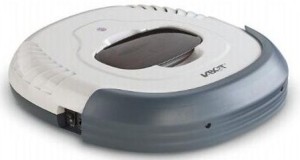A few years ago, Barbara and I saw an exhibition of the Roomba®, a robotic vacuum cleaner that patrolled a small patch of floor delimited by two-by-fours. Disk-shaped and about three inches thick, it buzzed and whirred, glanced off the barriers, and turned half or three-quarter pirouettes on the little wheels underneath. Unanswered by this demonstration was how well it cleaned floors.“That can’t possibly work,” I told Barb, “and look at the price: it’s almost two hundred bucks. What a rip-off.” We both laughed, and forgot the weird little machine.
In 2006 I was waiting for the results of a test for a brain tumor, when my favorite household gadget and useless accessory catalog arrived in the mail. There it was on the front page, a robotic vacuum costing only fifty dollars and promising to “pick up dirt, dust, hair and more from wood, carpet, vinyl and tile floors!” My judgment collapsed. “I deserve a little distraction from all this worry about the tumor,” I told myself as I placed my order. I felt guilty, but just as quickly found the excuse I needed: “Well, it’s not much money and it might be fun. Besides, if I can get it to work in just one or two rooms, it could be worth it.” The mind that rationalized this purchase just as easily suppressed the memory of the Consumer Reports article that panned robotic vacuums as next to useless.
I unpacked the new machine a few days later, charged it up and turned it loose in the living room. It rolled and whirred, just like the Roomba®. It bounced off a couple of obstacles and sought refuge under a table. Each time it struck a table leg it pivoted neatly and charged into another leg. Our two cats, who flee at the sound of a real vacuum cleaner, ignored it.
Its major flaw, not to be deduced from the advertising, was obvious: it had no memory of where it had been. How long, I wondered, would it take to extricate itself from under the table in the corner of the large and still to be vacuumed room? At last, the robot broke free and headed for the large rubber plant in the corner.
A few days later, after learning that I didn’t have the brain tumor that I had used to excuse buying it the first place, I tried the vacuum out in my study, which has a plastic mat under my chair to protect the floor. I left the room. After twenty minutes, it fell silent. Did the battery run down? No. It stalled trying to get over the one-eighth inch edge of my floor mat and had shut itself off. To its credit, it had collected a couple of dust bunnies, but two white paper punched-out holes lay undisturbed next to my desk.
I now understood why it sold so cheaply. Pricier models, I learned, come equipped with a remote control, supplying what every memoryless robot needs, some means for a human operator to tell it exactly what to do.
Next week: Fireworks at 18 Pearl


